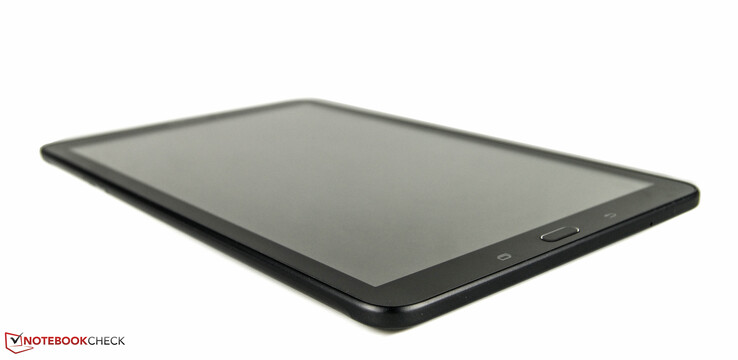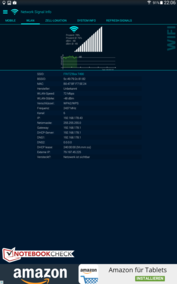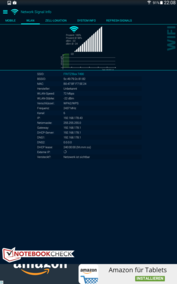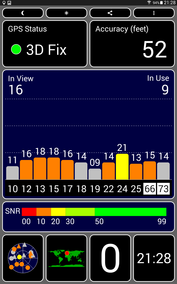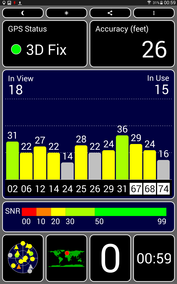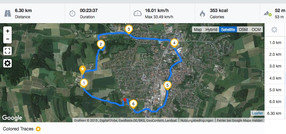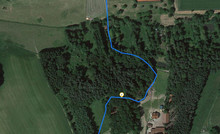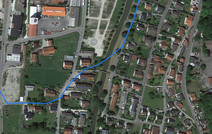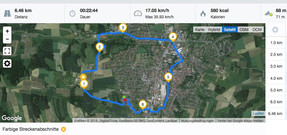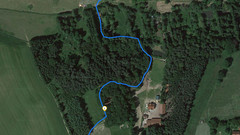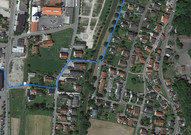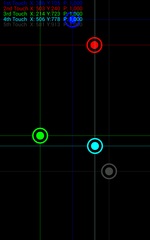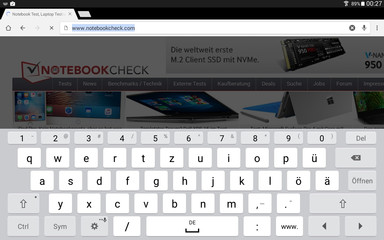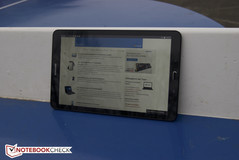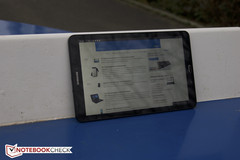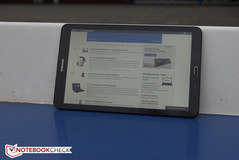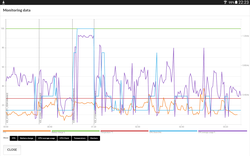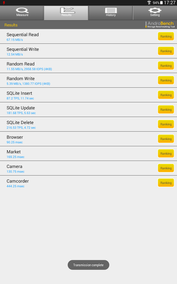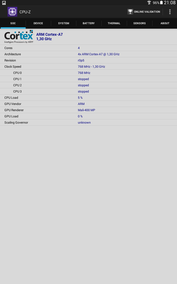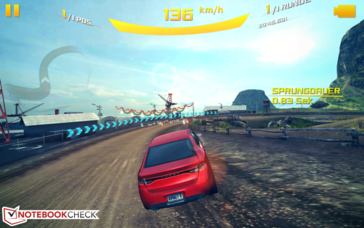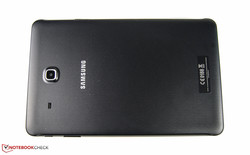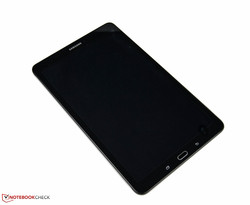Samsung Galaxy Tab E (9.6-inch, WiFi) T560N Tablet Review

Right at the end of the year, Samsung releases a new entry-level 9.7-inch tablet. Equipped with a quad-core processor, 1.5 GB of RAM, and 8 GB of storage, the Tab E offers just the basics - but at a low entry-level price of 180 Euro (~$200). Even at this price point, a certain standard can be expected and the series offers two cameras and an HD display; 3G is optional and costs 20 Euro (~$22) more. We are taking a look at the WiFi-version of the Tab E to see how it stacks up to competitors like the Lenovo Tab 2 10, the Acer Iconia Tab 10 A3 and the Medion Lifetab S10345. Of course we are also going to mention tablets from other manufacturers during our review and will take a look at higher-priced devices as well - for example the Samsung Galaxy Tab S2 9.7, which costs three times as much.
Case
Visually, the Galaxy Tab E looks quite similar to other mobile Samsung devices and in fact has an uncanny resemblance to the Samsung Galaxy Note 3 Neo smartphone. In contrast to the Galaxy Tab S2, which costs 400 Euro ($435), Samsung uses a case made from plastic, which the company claims to be "fabric-style" - likely because of the pattern on the back.
As far as the construction is concerned, Samsung did everything right. The different sections fit together without gaps and the corners are rounded nicely. Thanks to the rough back panel the tablet is non-slip. The 5 MP camera protrudes slightly and features a chrome bezel. The Samsung logo is not chrome-plated though, which is different from many smartphones and tablets.
Weighing in at 490 g, the Tab E isn't one of the lightest tablets out there. Other competitors in this price bracket - for example the Lenovo Tab 2 A10-70 and the Acer Iconia Tab 10 A3 - weigh about as much though.
The tablet can't be opened up easily, which is something Samsung probably intended. The only way to get to the inside necessitates the removal of the display. Consequently it's also not possible to swap out the battery.
Connectivity
A Spreadtrum SC7730S provides processing power. The 32-bit ARM quad-core (Coretex A7) CPU runs at up to 1300 MHz and is augmented by 1.5 GB of system RAM. Although it costs the same, the Lenovo TAB 2 comes with 2 GB.
The review slate comes with 8 GB of flash storage; about 5 GB are user accessible. The storage can be expanded with a microSD card up to 128 GB. Since App2SD is supported, installed applications can be relocated to the SD card.
The Tab E has the power and the headphone jacks on the upper edge, which is different from its upscale sibling.
The inexpensive review tablet doesn't feature MHL or NFC and OTG isn't supported, either.
Software
The pre-installed OS Android 4.4 Kitkat is a bit behind the times - we'll have to wait and see if Samsung decides to offer an update to a never version.
Operating the tablet is generally possible without an stutters, although animations sometimes lag a little. Users who normally work with more powerful tablets are more likely to notice this behavior. On their homepage, Samsung promises a better multitasking functionality, which allows programs to be used in parallel. The applications have to support this feature, however. During our test, YouTube and a browser ran in parallel without a hitch.
We should also mention here that the Tab E doesn't support S Voice.
As shipped, the Tab E not only contains the standard, but also some third-party apps (which can be uninstalled if so desired). Overall, the software package is far from generous. Aside from the well-known Google-programs, Samsung only preinstalled six additional apps.
Communication & GPS
Wireless communication is courtesy of a WLAN module operating at 2.4 GHz. According to the specs, the IEEM 802.11 b/g/n standard supports speeds of up to 600 Mbit/s.
To check the WLAN reception, we conduct two tests. For the first, we are one floor above our router (AVM Fritz!Box 7490). Here, the signal quality is quite good at -48 dBm (signal strength at 78 %). We also test the signal strength right next to the router: in this case, we measure -22 dBm (signal strength100 %).
Our Tab E doesn't support other mobile communication standards, although there is a 3G version which supports both 3G and 4G networks. The surcharge at this time is about 20 Euro (~$22).
To establish the location, the tablet can make use of both GPS and GLONASS. The connection process took quite a while inside, even though the apartment is located on the top floor (5th) of the building. Outdoors, the connection is established quickly and accurately.
As far as the GPS is concerned, there are noticeable differences in quality between the Tab E and the bike-specific Garmin Edge 500, which of course is a purpose-oriented design. Even though the tablet still does well overall, the professional device is much faster and more accurate.
Cameras & Multimedia
The Galaxy Tab E features two cameras. The main unit is on the back and comes with a resolution of 5 MP. The front-facing unit has a resolution of only 2 MP. Neither camera features an LED flash and only the rear-facing camera supports autofocus. Video recording is possible at the HD resolution of 1280 x 720 pixels at a frame rate of 30 fps. A more thorough examination reveals decent photo quality and the rear-facing camera is capable of taking nice pics as long as the environment is bright enough. Sharpness and details are quite OK considering the price, but the colors could be a little bit more saturated. In low light conditions, the camera and the corresponding software struggle more and the graininess is high. The front-facing unit - oftentimes called a "selfie" camera - does exactly what it was designed for and is suitable Skype conferencing or snapping smaller selfies. The focal length is fixed, but most comparable products are no different.
Accessories
Pretty standard as well is the lack of accessories - only a power adapter is included. Dedicated accessories are sparse as well: the homepage only lists a leather-like cover. The cover is available in white, brown and black and sells for around 25 Euro (~$27).
Warranty
In Germany, the tablet is covered against defects for two years, although the battery is exempt and only protected for 12 months. Accessories are only guaranteed for 6 months.
Input & Operation
The capacitive touchscreen accepts inputs without a hitch and the glass surface accepts up to five fingers simultaneously. Other units - for example the Lenovo TAB 2 A10 - are able to recognize up to ten fingers though.
Samsung has their own virtual keyboard, which supports automatic text recognition or swyping. The user can also reduce the size of the keyboard and move it around on the screen. In landscape mode, typing is not a problem, although we never used more than two or three fingers per hand. After practicing for a while, we were able too type at about half the speed we achieve when using a regular keyboard and the 10-finger method.
Display
Samsung's new entry-level tablet features a 9.6-inch display with a resolution of 1280 x 800 pixels. Because of the low resolution and the corresponding pixel density of 157 ppi, individual pixels are identifiable with the naked eye. The Lenovo TAB 2 does it better, as its 10-inch display supports a resolution of 1920 x 1200 Pixel at 224 ppi. Even though the resolution isn't that great, the average brightness is very acceptable at 452 cd/m². The glossy panel can thus overpower some reflections in really bright environments. The tablet maintains the maximum brightness even when not plugged in, which is of course very important.
| Samsung Galaxy Tab E (9.6, Wi-Fi) Mali-400 MP, SC8830, 8 GB eMMC Flash | Lenovo TAB2 A10-70 Mali-T760 MP2, MT8165, 16 GB eMMC Flash | Acer Iconia Tab 10 A3-A20 (NT.L5DEE.003) Mali-450 MP4, MT8127, 16 GB SSD | Medion Lifetab S10345 HD Graphics (Bay Trail), Z3735F, 32 GB SSD | |
|---|---|---|---|---|
| Screen | 22% | -9% | -17% | |
| Brightness middle (cd/m²) | 457 | 352.9 -23% | 356 -22% | 294 -36% |
| Brightness (cd/m²) | 453 | 335 -26% | 339 -25% | 281 -38% |
| Brightness Distribution (%) | 87 | 88 1% | 90 3% | 88 1% |
| Black Level * (cd/m²) | 0.49 | 0.191 61% | 0.42 14% | 0.5 -2% |
| Contrast (:1) | 933 | 1848 98% | 848 -9% | 588 -37% |
| Colorchecker dE 2000 * | 5.75 | 4.31 25% | 6.51 -13% | 5.78 -1% |
| Greyscale dE 2000 * | 5.33 | 4.36 18% | 5.92 -11% | 5.61 -5% |
| Gamma | 2.61 84% | 2.33 94% | 2.21 100% | 2.67 82% |
| CCT | 6820 95% | 7045 92% | 6736 96% | 7439 87% |
* ... smaller is better
| |||||||||||||||||||||||||
Brightness Distribution: 87 %
Center on Battery: 457 cd/m²
Contrast: 933:1 (Black: 0.49 cd/m²)
ΔE ColorChecker Calman: 5.75 | ∀{0.5-29.43 Ø4.78}
ΔE Greyscale Calman: 5.33 | ∀{0.09-98 Ø5}
Gamma: 2.61
CCT: 6820 K
At maximum brightness, black doesn't look very saturated. Our measurements confirm a black value of 0.49 cd/m². Once again, the Lenovo Tab 10 pulls ahead with a black value of 0.191 cd/m². The brightness of the Tab 10 is 100 cd/m² lower, though.
Our CalMan analysis shows DeltaE-deviations of between 5 and 6 for both colors and grayscale - an about average result for an IPS panel. The competitors aren't much better, but the expensive Samsung Galaxy Tab S2 has DeltaE-deviations of around one. The color temperature of 6820 K is not that far from the ideal of 6500K and can still be considered pretty "warm".
Of course tablets are suited well for mobile use, so we are very interested how the Tab E handles the outdoors. Even though the panel is glossy, working is possible even in bright environments. We do recommend staying away from direct sunlight, as it can overwhelm the display.
Performance
The 9.6-inch tablet comes with a Spreadtrum SC7730SE. The quad-core (ARM Cortex-A7) CPU runs at up to 1300 MHz, but can drop to around 770 MHz if the demand is low or to support energy-saving measures. The ARM Cortex-A7 was released four years ago, so from a performance standpoint the CPU is pretty entry-level. Graphics are handled by an ARM Mali 400 MP4, which is only found in smartphones these days. The Mali 450 is more widely used in this price bracket. Consequently, our review slate does worse than the competitors in pretty much all benchmark tests and only be compared to older tablets from 2014. For that reason, we've included smartphones with the same GPU and older tablets like the Medion Lifetab S10334Test Medion Lifetab S10334 Tablet in our comparison table.
An examination of the clock speed during the 3DMark and PCMark benchmark tests also explains the bad results, since the CPU can barely ever run at the nominal speed. At times, we observed dips to under 400 MHz.
| Geekbench 3 | |
| 32 Bit Single-Core Score (sort by value) | |
| Samsung Galaxy Tab E (9.6, Wi-Fi) | |
| Lenovo TAB2 A10-70 | |
| HP Pavilion 10-k000ng x2 | |
| Lenovo Yoga Tablet 2 1050F | |
| Acer Iconia Tab 10 A3-A20 (NT.L5DEE.003) | |
| Medion Lifetab S10345 | |
| Medion Lifetab S10334 | |
| LG Bello II | |
| 32 Bit Multi-Core Score (sort by value) | |
| Samsung Galaxy Tab E (9.6, Wi-Fi) | |
| Lenovo TAB2 A10-70 | |
| HP Pavilion 10-k000ng x2 | |
| Lenovo Yoga Tablet 2 1050F | |
| Acer Iconia Tab 10 A3-A20 (NT.L5DEE.003) | |
| Medion Lifetab S10345 | |
| Medion Lifetab S10334 | |
| LG Bello II | |
| 3DMark - 1280x720 Ice Storm Standard Score (sort by value) | |
| Samsung Galaxy Tab E (9.6, Wi-Fi) | |
| Lenovo TAB2 A10-70 | |
| HP Pavilion 10-k000ng x2 | |
| Acer Iconia Tab 10 A3-A20 (NT.L5DEE.003) | |
| Medion Lifetab S10345 | |
| Medion Lifetab S10334 | |
| LG Bello II | |
| Doogee Nova Y100X | |
| PCMark for Android - Work performance score (sort by value) | |
| Samsung Galaxy Tab E (9.6, Wi-Fi) | |
| Lenovo TAB2 A10-70 | |
| Doogee Nova Y100X | |
| Smartbench 2012 | |
| Productivity Index (sort by value) | |
| Samsung Galaxy Tab E (9.6, Wi-Fi) | |
| Lenovo TAB2 A10-70 | |
| Lenovo Yoga Tablet 2 1050F | |
| Acer Iconia Tab 10 A3-A20 (NT.L5DEE.003) | |
| Medion Lifetab S10345 | |
| LG Bello II | |
| Doogee Nova Y100X | |
| Gaming Index (sort by value) | |
| Samsung Galaxy Tab E (9.6, Wi-Fi) | |
| Lenovo TAB2 A10-70 | |
| Lenovo Yoga Tablet 2 1050F | |
| Acer Iconia Tab 10 A3-A20 (NT.L5DEE.003) | |
| Medion Lifetab S10345 | |
| LG Bello II | |
| Doogee Nova Y100X | |
| BaseMark OS II - Overall (sort by value) | |
| Samsung Galaxy Tab E (9.6, Wi-Fi) | |
| Lenovo TAB2 A10-70 | |
| LG Bello II | |
| Doogee Nova Y100X | |
Gaming
The less-than-stellar performance doesn't impact gaming too much. Older and casual titles don't pose much of a problem for the new Samsung slate. Angry Birds runs without any stutters, for example. Demanding games like Asphalt 8 are a different story and the frame rate is too low. Gameplay is possible only at the lowest settings, but we still encountered some lag and stutters regardless.
Emissions & Energy
Temperature
As far as the temperatures are concerned, we can only find positive things to say. Neither idle nor load are an issue. The hotspot - located on the display - only reaches 34 °C. The power adapter doesn't get hot, either: we measured 35.7 °C during idle and 38.4 °C under load. The thinner and more powerful Samsung Galaxy S2 reaches up to 41 °C. Other competitors in the same price bracket are quite comparable.
Before we move on, we also want to take a look at the clock speeds. Here, we task the Galaxy Tab E with the tool "Stability Test". Even though we observed low frequencies during the benchmarks, this test reveals a constant clock speed. This could potentially be due to a refresh-error of the software. In the beginning, the graphics simulation is quite fluent, but the frame rates drop as time progresses.
(+) The maximum temperature on the upper side is 34.1 °C / 93 F, compared to the average of 33.7 °C / 93 F, ranging from 20.7 to 53.2 °C for the class Tablet.
(+) The bottom heats up to a maximum of 34.7 °C / 94 F, compared to the average of 33.2 °C / 92 F
(+) In idle usage, the average temperature for the upper side is 29.2 °C / 85 F, compared to the device average of 30 °C / 86 F.
Speaker
Considering the size and the mobility factor, the tablet's speaker is actually quite decent and the quality sufficient for watching a few series or YouTube videos. Maximum volume is fairly loud and voices can be understood easily. Bass and a decent sound stage require the use of external speakers or headphones, however.
Power consumption
During idle, the test tablet never consumed more than about 4 W. Even under load, the maximum remained quite low at 6.2 W. More potent tablets in this size require up to 50 % more power. During standby, the tablet consumes only 0.1 W. When the Tab E is turned off, the power meter indicated zero drain.
| Samsung Galaxy Tab E (9.6, Wi-Fi) Mali-400 MP, SC8830, 8 GB eMMC Flash | Acer Iconia Tab 10 A3-A20 (NT.L5DEE.003) Mali-450 MP4, MT8127, 16 GB SSD | Medion Lifetab S10345 HD Graphics (Bay Trail), Z3735F, 32 GB SSD | Lenovo Yoga Tablet 2 1050F HD Graphics (Bay Trail), Z3745, 16 GB eMMC Flash | |
|---|---|---|---|---|
| Power Consumption | -31% | 39% | -16% | |
| Idle Minimum * (Watt) | 1.1 | 2.1 -91% | 0.8 27% | 1.5 -36% |
| Idle Average * (Watt) | 3.9 | 4.7 -21% | 1.1 72% | 3.7 5% |
| Idle Maximum * (Watt) | 4.1 | 4.9 -20% | 1.4 66% | 4.1 -0% |
| Load Average * (Watt) | 5.2 | 6.2 -19% | 4.5 13% | 6.7 -29% |
| Load Maximum * (Watt) | 6.2 | 6.4 -3% | 5.3 15% | 7.5 -21% |
* ... smaller is better
| Off / Standby | |
| Idle | |
| Load |
|
Key:
min: | |
Battery Life
The review tablet houses a lithium-ion battery with a capacity of 5000 mAh - an astounding 2200 mAh less than the Lenovo TAB 2 and 2700 mAh less than the Acer Iconia Tab 10 A3. Samsung claims run times of up to 8 hours while surfing the web - a claim we are going to take a closer look at.
First we check the minimum run time by turning the display to the maximum brightness and running the tool "Stability Test". The tablet shut down after about 4.5 hours. The Lenovo Tab 2 A10 lasted a little over seven hours; the Acer Iconia Tab also bested the Tab E by 30 min.
The most important test simulates web browsing. At an average brightness, the tablet managed about 8.5 hours; the competition lasts about as long. An outlier is the Lenovo Yoga 2, which surprised us with its 12.5 hours.
Last but not least we also take a look at the maximum possible battery life. With the brightness turned all the way down, the Tab E ran a script simulating reading for a little over 14 hours.
| Battery Runtime - WiFi Websurfing (sort by value) | |
| Samsung Galaxy Tab E (9.6, Wi-Fi) | |
| Lenovo TAB2 A10-70 | |
| Samsung Galaxy Tab E (9.6, Wi-Fi) Mali-400 MP, SC8830, 8 GB eMMC Flash | Medion Lifetab S10345 HD Graphics (Bay Trail), Z3735F, 32 GB SSD | Acer Iconia Tab 10 A3-A20 (NT.L5DEE.003) Mali-450 MP4, MT8127, 16 GB SSD | Lenovo Yoga Tablet 2 8 HD Graphics (Bay Trail), Z3745, 32 GB eMMC Flash | HP Pavilion 10-k000ng x2 HD Graphics (Bay Trail), Z3736F, 32 GB eMMC Flash | |
|---|---|---|---|---|---|
| Battery runtime | 5% | 3% | -3% | -9% | |
| Reader / Idle (h) | 14.2 | 14.9 5% | 12.8 -10% | 13.8 -3% | 12.6 -11% |
| Load (h) | 4.4 | 4.6 5% | 5.1 16% | 4.1 -7% |
Pros
Cons
Verdict
Samsung's Galaxy Tab E is an well-executed entry into the world of tablets. The review slate is solid and features all required communication modules as well as two cameras. The build quality is without flaw and the size is a good compromise. The IPS display is very bright and better than what's usually offered. The main drawback is the performance: the hardware could be a little more powerful since throttling occurs already at the beginning of benchmark tests. Users who want a tablet for web browsing and occasional gameplay won't really notice, however. We also like the low temperatures and the loud speaker.
The Samsung Tab E is a well-rounded tablet which - at a price of 180 Euro ($200) - leaves us with an overall favorable impression.
The Galaxy Tab E doesn't quite rule the low-price segment, but it is definitely a worthy choice. We do recommend looking at the competitors Lenovo Tab 2 or Lenovo Yoga 2 as well.
Samsung Galaxy Tab E (9.6, Wi-Fi)
- 01/05/2016 v4.1 (old)
Nino Ricchizzi




